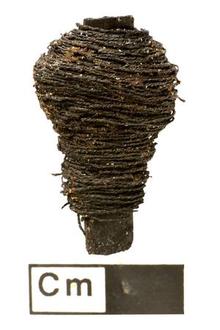In a surprising twist, an unusually delicate couple of artifacts have recently arisen from a dig site in the United Kingdom. Archaeologists in England have officially discovered a fragile ball of yarn and another thread wound inside of a bobbin that is over 3,000 years old.
In 2011, the Cambridge Archaeological Unit, in collaboration with Forterra, began to uncover a series of incredible discoveries that has become known as one of the most important Bronze Age sites across Europe.
Among the amazing discoveries, two fragile fiber objects were unearthed during an excavation of a village that thrived during the Bronze Age.
The village is located near the city of Peterborough, in modern day England. The excavation site is known as Must Farm and is thought to have been quickly abandoned after a fire abolished most of the settlement thousands of years ago.
During the settlement’s abandonment, many artifacts were left behind that gave our current archaeologists insights to what every-day life was like in a Bronze Age settlement. The objects that were left behind are finally being discovered and brought to light for the first time.
The first fiber object, a miniscule thread, is still neatly wound. The archaeologists said the thread was well preserved and that the condition they found it in was said to be “amazing”.
A picture was uploaded to Facebook on July 21st and quickly sparked dozens of questions from around the world. In the mini Q&A, the team of experts explained that the thread was probably incredibly preserved because it was created from plant fiber, which more than likely consisted of a flax or nettle base.

Luckily for archaeologists, this allowed the plant matter to carbonize inside of the fire and then shortly after the thread became waterlogged – the process that helped protect it for thousands of years.
Although the thread is greenish-brownish today, archaeologists indicate the thread was likely a different color before it was set on fire, flooded, and then buried.
And it is impractical that an incredibly careful cleaning and preparation process would give scientists any hint on how to restore its original hue.
The archaeologists said in a comment on Must Farm’s Facebook page that the reason behind this is that the same process of carbonization that preserved the thread for so long also removed all traces of pigment inside of thread itself.
Close to the thread ball, a small bobbin was also found with thread wrapped around it. It is also said to be in excellent condition, the archaeologists Cambridge Archaeological Unit confidently declared.
They are doing everything possible to properly extract sediment from the fibers before it is lifted, the archaeologists confirmed on Facebook.
The thread wrapped around the bobbin was luckily incredibly preserved, and the archaeologists described it as looking practically new.
And even though the 3,000-year-old thread has stolen the show, it is just one of an amazing variety of beautifully-preserved objects that have been discovered at Must Farm excavation site due to the fire that drove the population away from the settlement and left the village untouched.

A few other examples of objects unearthed are pottery, woven textile, a bronze sickle, a weapon head, and even some glass jewelry that allows us to gain a glimpse into what culture was like during the Bronze Age.
Even though the fire was a major factor in the discovery and preservation of the village, it is still a mystery as to what started the fire that left an entire village homeless.
Though archaeologists hinted that it’s possible it was deliberately set by grumpy neighbors, there is still no published evidence that back those speculations.
The amazing thing about this excavation site is how good a time capsule this fire created for today’s most premier study of history. This village was living its daily life, and the population’s exit was sparked by a single catastrophic event.
It is due to this fact that the Must Farm settlement has been heralded as one of the most complete Bronze Age assemblages ever discovered inside of the United Kingdom. It has implicitly given us unprecedented insight into what life was like for humanity 3,000 years ago.
Archaeologists are working hard to delicately excavate the site so they can assemble the story of this village.
The excavation is just the beginning and once it is complete the much more extravagant process of preserving, preparing, and putting together the puzzle pieces to spark a story of their discoveries begins.
Stay tuned for more updates because assembling the story of this Bronze Age village can take years to complete.